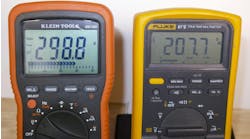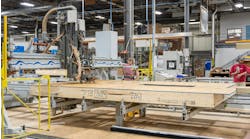ALEXANDER TOENNIES
Title: Electrical Engineer
Company: Donco Electrical Construction LLC dba Utility Design Services
Location: Edwardsville, Ill.
Age: 24
Years on the job: 2.5 years
Alexander Toennies’ first experience with the electrical industry can be traced back to 2004, when he was in fourth grade. At that point in time, his family was building a new house, and he helped his father and grandfather wire his home by hooking up receptacles/phone jacks and installing cover plates. Years later, he married into a family specializing in residential wiring work, and he continues to help his wife’s father and brother during busy times.
“I initially wanted to be an electrician, but a family friend told me to get my engineering degree first,” Toennies says. “If I still wanted to wire after that, he told me I can always go back to it.”
Toennies, who was born in Breese, Ill., graduated in three years with a bachelor’s degree in electrical engineering from Southern Illinois University-Edwardsville by taking a full load and classes every summer. In the summer of 2014, he started off as an intern for Utility Design Services, and he continued working for the company as he finished his last two semesters of college.
On his first project, he contacted customers if their residential service entrances violated NESC clearance standards. By meeting with the customers, he could hear the opposite side of every story.
“I believe that this gave me a greater respect for all customers that I would see in the future, and a push to listen to all of their reasoning behind a decision — not just what we wanted to hear,” he says.
As an engineer for Utility Design Services, he sees many different projects come through — from design for distribution, sub-transmission, fiber, and substations.
“Everyone has a chance to work in every aspect of the industry,” he says. “It keeps the job from becoming boring and redundant.”
Another way that he has infused excitement into his day-to-day job is by staying current with technology.
“Technology is a growing part of every area of engineering, from automotive to agriculture to power,” he says. “To stay in business, companies must stay up-to-date with technological advancements.”
For example, he works with several rural electric cooperatives and municipalities in designing relay systems for existing substations to replace electromechanical relays with microprocessor relays. He has also designed sub-transmission circuits over existing distribution lines, substations and substation protection and control.
“It takes a lot of time and patience, due to the high amounts of detail in the design,” he says. “However, it keeps me thinking constantly.”
In his short time with Utility Design Services, he has also helped solve an age-old problem of how to train employees on relays. While training classes may be available for programming and testing, they are often very expensive and have a limited time to cover a vast area of offerings, he says. Also, trying to train employees on relays when commissioning a new site is out of the question because improperly designed panels can lead to significant damage. To circumvent these issues, he designed and built a relay test panel in the office for training purposes on relay testing and simulation.
“By designing and building a test relay panel, we will be able to train our current and future employees in relay testing without having to worry about these damages,” he says. “It also gives us greater efficiency in the field, therefore reducing the number of hours we are on site and reducing the final cost for the customer.”
His experience building and wiring relay panels, rather than just designing them, sets him apart from others in the field, he says. By seeing how everything is connected physically, it gives him a greater knowledge of how future designs should be arranged to increase not only efficiency in construction, but also overall neatness of the final project.
“I am a firm believer in the fact that I think every engineer in every industry needs to get out of the office or out from behind the desk and go either see how their designs are built, or even better, build their designs themselves,” he says.





